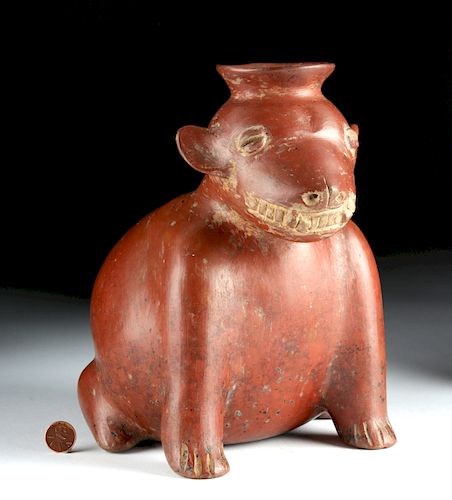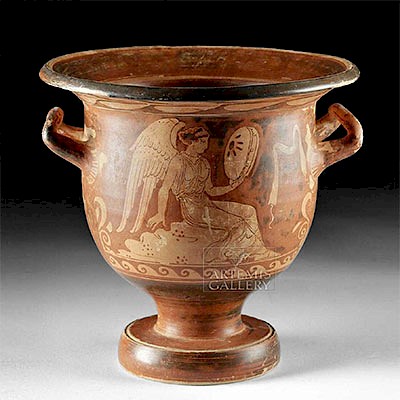Colima Redware Dog Effigy Vessel - Wide Grin
Lot 223
About Seller
Artemis Gallery
686 S Taylor Ave, Ste 106
Louisville, CO 80027
United States
Selling antiquities, ancient and ethnographic art online since 1993, Artemis Gallery specializes in Classical Antiquities (Egyptian, Greek, Roman, Near Eastern), Asian, Pre-Columbian, African / Tribal / Oceanographic art. Our extensive inventory includes pottery, stone, metal, wood, glass and textil...Read more
Estimate:
$2,500 - $3,750
Absentee vs Live bid
Two ways to bid:
- Leave a max absentee bid and the platform will bid on your behalf up to your maximum bid during the live auction.
- Bid live during the auction and your bids will be submitted real-time to the auctioneer.
Bid Increments
| Price | Bid Increment |
|---|---|
| $0 | $25 |
| $300 | $50 |
| $1,000 | $100 |
| $2,000 | $250 |
| $5,000 | $500 |
| $10,000 | $1,000 |
| $20,000 | $2,500 |
| $50,000 | $5,000 |
| $100,000 | $10,000 |
| $200,000 | $20,000 |
About Auction
By Artemis Gallery
Mar 7, 2019
Set Reminder
2019-03-07 10:00:00
2019-03-07 10:00:00
America/New_York
Bidsquare
Bidsquare : VARIETY SALE | Antiquities & Ethnographic Art
https://www.bidsquare.com/auctions/artemis-gallery/variety-sale-antiquities-ethnographic-art-3928
Around the world & back in time - be amazed at the treasures you will find. Antiquities from Egypt, Greece, Italy and the Near East, Asian, Pre-Columbian, African / Tribal / Oceanic, Native American, Spanish Colonial, Russian Icons, Fine Art, much more! Artemis Gallery info@artemisgallery.com
Around the world & back in time - be amazed at the treasures you will find. Antiquities from Egypt, Greece, Italy and the Near East, Asian, Pre-Columbian, African / Tribal / Oceanic, Native American, Spanish Colonial, Russian Icons, Fine Art, much more! Artemis Gallery info@artemisgallery.com
- Lot Description
Pre-Columbian, West Mexico, Colima, Protoclassic period, ca. 100 BCE to 250 CE. An adorable and sizeable hand-built pottery dog vessel with a flared spout emerging from atop its head. The highly-burnished vessel is defined by a quartet of attenuated legs, a corpulent torso, a curved back with a raised spinal column, and a perky conical tail. Incised coffee-bean-shaped eyes, a broad nose with drilled nostrils, perky ears, and a smiling mouth filled with teeth compose the stylized canine visage, and the entire figure is adorned in deep red slip. Size: 7.25" W x 9.25" H (18.4 cm x 23.5 cm).
The Colima Dog is one of the most enduring and famous symbols of Pre-Columbian art. These puppies come from the shaft tombs of West Mexico, where dogs were believed to assist the dead in their journey to the underworld. Although these dogs are often portrayed as fattened up for the table, they are also sculpted into a variety of playful positions, suggesting that dogs were also close human companions in Colima culture the way they are today for us. This particular Colima dog sits at attention, mouth wide open brandishing a toothy grin, and tail projecting behind his short back legs, ears perked up and eyes looking outwards at the viewer. Anyone who loves dogs knows this expression and the piece demonstrates how important the bond between humans and dogs was even 2000 years ago! This close relationship is reflected in the cosmology of Pre-Columbian Mexican peoples, where one story tells that the first man survived a great flood because of his friend, a dog, who helped him find both corn to eat and fire.
Provenance: private Los Angeles County, California, USA collection
All items legal to buy/sell under U.S. Statute covering cultural patrimony Code 2600, CHAPTER 14, and are guaranteed to be as described or your money back.
A Certificate of Authenticity will accompany all winning bids.
We ship worldwide and handle all shipping in-house for your convenience.
#135823Restoration to portion of spout rim with some resurfacing and overpainting. Surface wear and abrasions commensurate with age as expected, small nicks to ears, nose, rim, tail, legs, and base, with light fading to slip pigmentation, and some fading to finer incised details. Light earthen deposits within recessed areas and nice mineral deposits throughout.Condition
- Shipping Info
-
All shipping is handled in-house for your convenience. Your invoice from Artemis Gallery will include shipping calculation instructions. If in doubt, please inquire BEFORE bidding for estimated shipping costs for individual items.
-
- Buyer's Premium



 EUR
EUR CAD
CAD AUD
AUD GBP
GBP MXN
MXN HKD
HKD CNY
CNY MYR
MYR SEK
SEK SGD
SGD CHF
CHF THB
THB
















